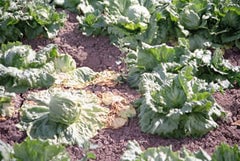California fires affecting produce supplies across North America
Our Golden State is on fire. But the burning land within California is largely wooded areas far away from agriculture, yet the smoke is so intense crops face secondary damages
California’s wildfire season usually extends from July to November – when hot, dry winds are most frequent – ending only when the first major rainstorm of the winter arrives. But this year, nearly 8,000 fires have burned more than three million acres, which is a record for the state of California. At one point, smoke covered almost half of California’s territory. Clearly, climate change has dramatically increased the risk of forest fires in California and elsewhere in the world. Further, a blistering heat wave throughout the state is causing damage to coastal crops.
These fires, coupled with the complexities brought about by the pandemic, mean things may get complicated this fall. While a third of the vegetables produced in the United States come from California, more than half of the fruits and nuts from the US are produced in the Golden State
The wildfires come amid a blistering hot summer that has seen temperatures soar above 110 degrees in inland valleys and even along the coast, notes the National Agricultural Statistics Service.

The heat and smoke are causing no shortage of complications as workers are harvesting a multitude of crops, including early-variety almonds, table grapes, plums, apricots, oranges and numerous summer vegetables.
As far as Canada, fires and weather are creating disruptions.
Each year, Canada imports approximately $3.1 billion-worth of food from California, according to the California Department of Food and Agriculture.
Other than wine, the foods we import the most are lettuce, almonds, strawberries, raisins, oranges, cauliflower, grapes, pistachios, onions, spinach and carrots. For the fall and winter months, the United States, and especially California, plays a key role in replenishing our grocery baskets. With our northern climate, we need import options to keep the cost of our food at a reasonable level. It has been this way for a long time.
Coastal crop damage
Harvests are also still in high gear for strawberries on the Central Coast, where periods of unusually high temperatures are causing damage, according to a University of California Cooperative Extension advisor. "Bottom line is that the heat is really killing the berries," blogged Mark Bolda, the UCCE's Santa Cruz County director. Fruit softened by heat is susceptible to vinegar flies and other pests, he wrote. Bolda urges pickers to look closely at berries, because fruit that looks sound on one side can be damaged on the other. Hot weather also worsens existing problems with root disease, he advised
What to expect in produce aisles
Last week we braced ourselves for an intense heat wave over the weekend and into Labor Day week. Temperatures reached over 110 degrees in many growing regions including Salinas Valley and Bakersfield. The heat affects our food production, putting not only the plants and fruit at risk but the people harvesting our food. Once the temperature reaches 90-95 degrees it is too hot to be in the field picking, and workers need to be sent home. Hot days and fewer hours to pick will affect supply and quality across various commodities.
Some summer fruits such as watermelon, tomatoes and melons like the heat, but if it gets too hot for an extended period of time the plants become stressed, interrupting their production cycle, slowing down the ripening process, and preventing necessary nutrients from reaching the plant. For many plants like tomatoes, new fruit will not set in high heat conditions. The flowers will not pollinate, leading to gaps in production down the road.
Expect to see a little sunburn on some lettuce varieties. Romaine and Butter lettuce will show the worst damage with browning around the top of the leaves. Prices will continue to rise on lettuce, broccoli, cauliflower, iceberg, sweet baby broccoli amongst others.
Seedless watermelons are almost finished for the season. The mini seedless were another victim of the excessive heat.
Excessive heat over the last month has stressed out the Valencia orange trees and caused the fruit to re-green and develop a green cast. In order to protect themselves, the fruit trees begin the photosynthesis process and transfer energy in the form of nutrients from the fruit back into the tree.
Several herb local Bay Area growers are reporting severe damage to crops, in particular basil, from the heat. The plants need a recovery period of at least 7-10 days; depending on crop damage, it could be longer.
Snap Peas gapping for a week to two weeks as they recover from the heat and sunburn.
Artichokes open to flower in the heat. Production has been reduced 50%.
Zucchini grew too fast because of the heat and had to be pulled off the plant. Supply will tighten up.
Growers are reporting sunburn on hot pepper plants as well as tomato plants. Habaneros and cayenne will hopefully be back in a week. The tomatoes that were cooked will need to be pulled off the vine and composted. The good news is that the sunburned pepper and tomato plants will recover.
The extent of the damage from the heat is currently unknown, but there is a good chance we will see shortages in production down the road. We will continue to update you as we know more.
Did you know that the blockchain can be used to monitor and help prevent wildfires in California?
Read more here!

